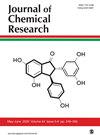关于生物色素分子颜色-结构关系的密度泛函理论/时间相关密度泛函理论研究
IF 1
4区 化学
Q4 CHEMISTRY, MULTIDISCIPLINARY
引用次数: 0
摘要
生物染料分子衍生物的研究对于印染和纺织工业的绿色转型具有重要意义。本研究采用 B3LYP 密度泛函方法对所选分子的几何构型进行优化,并探索生物染料分子的结构与颜色之间的关系及其着色机理。本研究重点分析了纺织业常用颜色:蓝、黄、紫、红、绿等中的烯烃类、醌类、吲哚类和叠氮类生物染料。量子化学研究表明,生物染料的共轭结构与其颜色直接相关,影响共轭结构的基团或结构在很多情况下会导致颜色的改变。此外,用 CAM-B3LYP 函数对紫外-可见光谱进行的随时间变化的密度泛函理论光谱计算表明,在可见光波段,减去吸收波长后剩余波段的颜色与颜料的颜色完全相同。这些结果表明,颜料的颜色与材料的光吸收颜色正好互补。我们的研究为生物染料分子衍生物的设计提供了理论指导,有望在一定程度上促进纺织、印染行业的绿色转型。本文章由计算机程序翻译,如有差异,请以英文原文为准。
Density functional theory/time-dependent density functional theory investigations on the color-structure relationship of biopigment molecules
The study of molecular derivatives of biological dyes is of great importance for the green transformation of the printing, dyeing, and textile industries. In this study, B3LYP density functional methods are used to optimize the geometric configuration of the selected molecules and to explore the relationship between the structure and color of biological dye molecules and their color mechanism. This study focuses on the analysis of polyenes, quinones, indoles, and azide biological dyes in colors commonly used in the textile industry: blue, yellow, purple, red, green, and so on. Quantum chemical investigations show that the conjugate structure of a biological dye is directly related to its color and that the group or structure affecting the conjugate structure will in many cases cause a change in color. In addition, time-dependent density functional theory spectral calculations with the CAM-B3LYP functional for UV-Vis spectra show that in the visible band, the color of the remaining band after subtracting the absorption wavelengths was exactly the same as the color of the pigment. These results indicate that the color of the pigment is exactly complementary to the light absorption color of the material. Our study provides theoretical guidance for the design of molecular derivatives of biological dyes and is expected to promote the green transformation of the textile, printing, and dyeing industries to a certain extent.
求助全文
通过发布文献求助,成功后即可免费获取论文全文。
去求助
来源期刊

Journal of Chemical Research
CHEMISTRY, MULTIDISCIPLINARY-
CiteScore
2.30
自引率
0.00%
发文量
66
审稿时长
1.0 months
期刊介绍:
The Journal of Chemical Research is a monthly journal which has a broad international authorship and publishes research papers and reviews in all branches of experimental chemistry. Established in 1977 as a joint venture by the British, French and German chemical societies it maintains the high standards set by the founding societies. Each paper is independently peer reviewed and only carefully evaluated contributions are accepted. Recent papers have described new synthetic methods, new heterocyclic compounds, new natural products, and the inorganic chemistry of metal complexes.
 求助内容:
求助内容: 应助结果提醒方式:
应助结果提醒方式:


